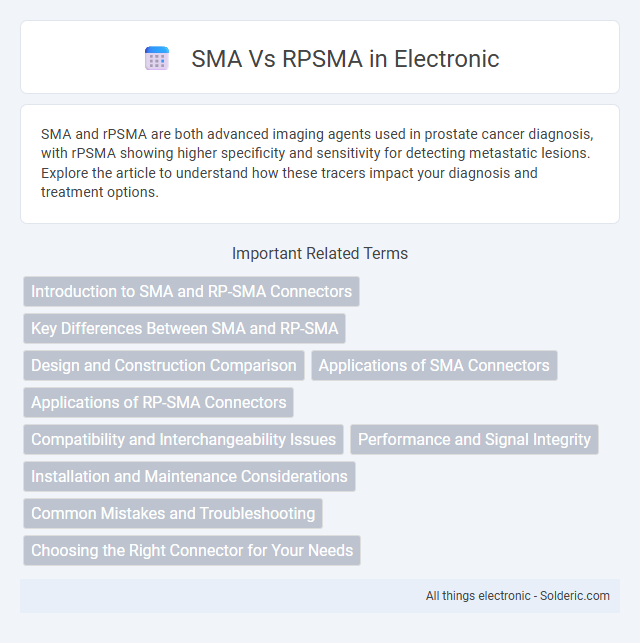SMA and rPSMA are both advanced imaging agents used in prostate cancer diagnosis, with rPSMA showing higher specificity and sensitivity for detecting metastatic lesions. Explore the article to understand how these tracers impact your diagnosis and treatment options.
Comparison Table
| Feature | SMA Connector | RPSMA Connector |
|---|---|---|
| Full Name | SubMiniature version A | Reverse Polarity SubMiniature version A |
| Gender Configuration | Standard male/female | Reversed gender roles to meet regulatory requirements |
| Use Case | Common in RF applications, antennas, and test equipment | Designed to restrict unauthorized antenna connection, commonly used in Wi-Fi devices |
| Connector Pin | Male: center pin male; Female: center socket | Male: center socket; Female: center pin (opposite of SMA) |
| Frequency Range | Up to 18 GHz typically | Up to 18 GHz typically |
| Regulatory Purpose | No specific restriction | Complies with FCC rules to restrict antenna modifications on consumer devices |
| Physical Size | Compact, 8mm hex nut | Same as SMA for compatibility |
| Application Example | Cellular network antennas, RF test instruments | Wi-Fi routers, wireless LAN adapters |
Introduction to SMA and RP-SMA Connectors
SMA connectors are precision-engineered RF connectors known for their durability and high-frequency performance up to 18 GHz, commonly used in wireless communication systems. RP-SMA connectors feature a reversed polarity design, altering the gender of the center pin to prevent accidental mating with standard SMA connectors, ensuring compatibility in specific applications like Wi-Fi devices. Understanding the distinct functions and physical differences of SMA and RP-SMA connectors helps you select the appropriate connector for your RF or networking setup.
Key Differences Between SMA and RP-SMA
SMA connectors feature a threaded design that ensures a secure, weather-resistant connection commonly used in microwave systems, while RP-SMA connectors reverse the gender of the inner pin and socket, primarily designed to comply with FCC regulations for Wi-Fi devices. RP-SMA connectors prevent users from connecting non-compliant antennas, making them essential for maintaining legal transmission power limits in wireless networking. Understanding these key differences helps you select the appropriate connector type for your RF applications and ensures compatibility with your devices.
Design and Construction Comparison
SMA (SubMiniature version A) connectors feature a threaded interface ensuring secure, high-frequency signal transmission commonly used up to 18 GHz. RP-SMA (Reverse Polarity SMA) connectors use a reversed gender configuration in their inner conductor, designed to prevent standard SMA mating and comply with regulatory standards for wireless equipment. Both connectors maintain similar dimensions and materials, typically brass with gold plating, but the RP-SMA's reversed design impacts device compatibility and assembly in RF applications.
Applications of SMA Connectors
SMA connectors are widely used in radio frequency (RF) applications including antennas, microwave systems, and wireless communication devices due to their durable threaded interface and excellent performance up to 18 GHz. RP-SMA connectors, featuring a reverse polarity design, are primarily implemented in Wi-Fi equipment and consumer wireless devices to prevent accidental mismatch with standard SMA connectors, enhancing compliance with regulatory standards. Both connector types provide reliable high-frequency electrical connections but are selected based on the specific application requirements and device compatibility.
Applications of RP-SMA Connectors
RP-SMA connectors are widely used in wireless communication devices, including Wi-Fi antennas, ZigBee modules, and GPS systems, where secure and reliable RF connections are essential. They are preferred in applications requiring a reverse polarity configuration to prevent accidental mating with standard SMA connectors, ensuring proper signal integrity. These connectors are also common in IoT devices and amateur radio setups, providing versatility and robustness in RF performance.
Compatibility and Interchangeability Issues
SMA connectors are widely used for general RF applications, while RP-SMA connectors feature reversed gender interfaces, leading to compatibility and interchangeability challenges between the two types. Devices with RP-SMA connectors cannot directly connect to SMA connectors without an adapter due to differing pin configurations, which prevents improper mating and potential damage. Understanding these differences is crucial for ensuring proper connection in wireless communication systems and avoiding signal loss or hardware issues.
Performance and Signal Integrity
SMA connectors provide reliable performance with moderate signal loss up to 18 GHz, making them suitable for general RF applications. Reverse Polarity SMA (RPSMA) connectors maintain similar electrical characteristics while preventing accidental mating with standard SMA connectors, ensuring signal integrity in secure installations. Your choice between SMA and RPSMA should consider compatibility requirements and the need for robust signal transmission in high-frequency environments.
Installation and Maintenance Considerations
SMA (SubMiniature version A) connectors offer straightforward installation with a screw-type coupling mechanism that ensures a reliable and durable connection, requiring minimal maintenance over time. In contrast, RP-SMA (Reverse Polarity SMA) connectors, designed to prevent accidental mating with standard SMA connectors, may require extra attention during installation to ensure compatible devices are correctly matched, which can slightly increase installation complexity. Your choice between SMA and RP-SMA should consider the ease of ongoing maintenance and the need for compatibility checks to avoid connector damage or signal loss.
Common Mistakes and Troubleshooting
Common mistakes when using SMA and RP-SMA connectors include incorrect mating due to opposite gender pin configurations, which can result in poor signal quality or damage to the connectors. Ensuring proper alignment and avoiding excessive force helps prevent cross-threading and connector wear. You can troubleshoot connection issues by inspecting the connector pins for bending or corrosion and verifying that the correct SMA or RP-SMA type matches your device specifications.
Choosing the Right Connector for Your Needs
Choosing the right connector between SMA and RP-SMA depends on your device's compatibility and antenna requirements. SMA connectors have a male pin that fits female RP-SMA connectors, which reverse the gender of the pin to prevent mismatched connections. Your optimal choice ensures reliable signal transmission and minimizes interference in wireless communication setups.
SMA vs RPSMA Infographic

 solderic.com
solderic.com